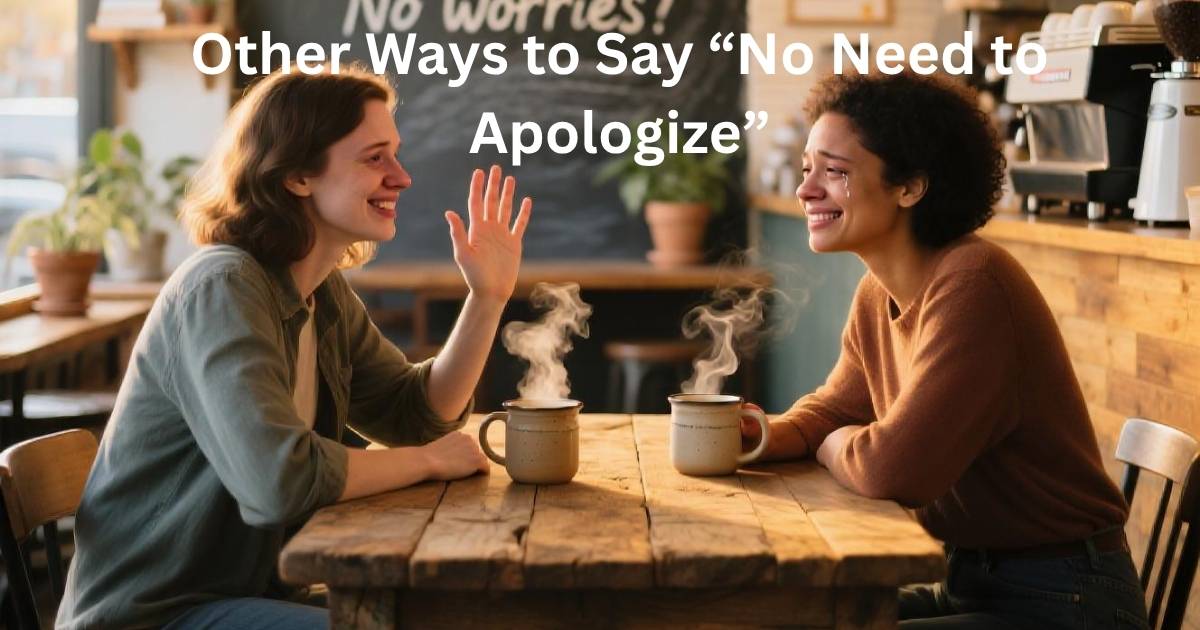In daily life, small mistakes and misunderstandings happen all the time, whether at work, with friends, or in casual conversations. Responding with kindness can turn an awkward moment into a chance to strengthen trust and connection. Saying No Need to Apologize is a gentle way to show empathy and keep the tone friendly. It helps reduce tension, especially when the issue is minor or already resolved. In both professional and personal settings, using No Need to Apologize can make the atmosphere warmer and more supportive.
It shows you value the relationship over the mistake itself. Instead of focusing on blame, you encourage a forward-moving, positive mindset. When you say No Need to Apologize, you create space for understanding, comfort, and stronger communication. This simple phrase, or its many alternatives, helps keep relationships balanced, conversations respectful, and moments of misunderstanding from becoming unnecessary sources of stress.
Main Points
- It helps keep the tone warm and the atmosphere light in conversations.
- Using it avoids adding awkwardness or tension to a situation.
- It works well in both professional and casual settings.
- It encourages a forward-moving mindset instead of focusing on blame.
- Alternatives like All good or No problem can make interactions more relaxed.
- It helps maintain trust and strengthen relationships.
- Using it can quickly resolve misunderstandings without stress.
- It’s effective when paired with positive body language and a friendly tone.
- It reinforces support, understanding, and respect in all types of communication.
All Good

“All good” is a light, casual way to tell someone their mistake is not a big deal. It works well with friends, coworkers, and even in quick chats at work. This phrase creates a relaxed atmosphere and makes the conversation feel less serious. In the USA, you’ll hear “All good” a lot when people want to move on quickly without extra stress.
If someone missed a small deadline on a project or came a little late to lunch, saying “All good” keeps the tone positive and supportive. It’s short, easy to say, and filled with understanding. This small phrase can make people feel safe from judgment, building better connections in relationships.
Sometimes all it takes is saying All good to make a person’s shoulders drop in relief. It’s a gentle way of letting them know that their mistake, delay, or oversight didn’t cause any real harm. The phrase works in a busy workplace just as well as at home. It’s like saying, “Don’t worry, we’re still on track.”
In casual conversations, All good also helps keep the tone light and positive. Imagine a friend spilling a drink on your table, you laugh and say All good, and suddenly the focus shifts from the accident to enjoying your time together. It’s small but powerful in building a relaxed atmosphere.
No Worries
“No worries” is friendly, quick, and full of reassurance. It’s often used in casual settings with friends or colleagues. When you say this, you’re telling the person there’s no concern and no reason to feel anxious. The tone is gentle, which makes it good for everyday life in the USA.
This phrase is helpful when someone apologizes for a minor delay or misunderstanding. For example, if your coworker says, “Sorry I was late to the meeting,” you can smile and say, “No worries.” It closes the issue and keeps everyone relaxed, helping the conversation flow with ease.
No worries works like a quick, friendly pat on the shoulder. It’s perfect when someone feels bad over something small, like running late or forgetting a minor detail. You’re telling them there’s no need to stress or keep apologizing.
This phrase also helps soften the mood in professional settings. If a coworker misses a deadline by a few hours, saying No worries lets them know you value solutions more than pointing fingers. It keeps communication open and friendly.
It’s Okay
“It’s okay” is one of the most common responses in American English. It works with people you know well and with strangers. This phrase shows empathy, understanding, and acceptance. When someone feels bad about an issue, telling them “It’s okay” is like giving comfort and relief.
You can use it in professional emails or face-to-face talks. For example, when a client apologizes for delays, you might say, “It’s okay, I understand things happen.” This balances politeness and human warmth, keeping trust and respect in the relationship.
It’s okay to have a warm and forgiving tone. It reassures the other person without making them feel judged. When someone makes a tiny mistake, hearing It’s okay makes them feel understood.
It’s also flexible. You can say it softly in a serious moment or cheerfully in a casual one. Either way, the message stays the same: you care more about the relationship than the mistake.
No Problem
“No problem” is simple but positive. You hear it often in customer service or when people want to sound friendly. It tells the other person that their apology is not necessary and that you’re not holding any concern.
In the USA, “No problem” works in both casual and professional settings, but your tone matters. Say it warmly so it doesn’t sound cold. This is especially important when talking to clients or colleagues, where rapport and trust are key.
When you say No problem, you’re signaling that the situation didn’t inconvenience you at all. It’s quick, clear, and puts the other person at ease.
It’s especially useful in service situations or workplace communication. Whether in an email reply or a casual chat, No problem sends the message that you’re willing to move forward without holding onto the issue.
Don’t Sweat It

“Don’t sweat it” is an informal American phrase that feels light and friendly. It means “Don’t worry about it” in a more playful way. This works great with friends, teammates, or coworkers you know well.
If a colleague makes a small mistake or forgets to send a message on time, saying “Don’t sweat it” adds a light-hearted feel to the conversation. It shows flexibility and understanding, keeping things relaxed instead of tense.
Don’t sweat it is casual, relaxed, and perfect for telling someone not to overthink a small error. It works well in friendly or informal settings where a bit of humor can help lighten the moment.
It’s also great for reminding people that mistakes happen to everyone. By saying Don’t sweat it, you’re inviting them to let go of worry and focus on what’s next.
Read this Also: 16 Other Ways to Say “Thanks for Checking In”
Find more words!
Sometimes, the best way to make someone feel better is to use your own words. Instead of only memorizing fixed phrases, think about the context, your relationship with the person, and their feelings. Maybe you’ll say, “I get it,” “Things happen,” or even make a joke to lighten the atmosphere.
Using different alternatives keeps your communication personal and shows emotional intelligence. It’s a way to show you truly understand them, building connection, trust, and even long-term rapport.
There’s no rule saying you have to stick with one phrase forever. You can swap No Need to Apologize for other gentle and reassuring words depending on the mood and setting.
Choosing the right expression can make your kindness feel more personal. A softer tone might work better with a friend, while something upbeat could fit a casual workplace chat.
You’re Fine
“You’re fine” feels soft and supportive. It’s perfect when you want to let someone know they didn’t cause a real issue. This phrase can help the other person feel less anxious and more comfortable.
If a friend apologizes for spilling coffee or a coworker worries about sending a file late, “You’re fine” works well. It’s short but filled with warmth and acceptance, helping maintain a positive mood in the conversation.
Saying you’re fine is like giving instant permission for someone to stop feeling bad. It’s short, friendly, and clears away any awkwardness in seconds.
This works especially well when someone overthinks a minor slip-up. By saying you’re fine, you help them relax and keep the moment stress-free.
No Big Deal
“No big deal” makes it clear that the mistake is trivial and not worth stress. It helps remove awkwardness from the situation and keeps the tone relaxed.
You can use this in professional and casual settings. For example, if a colleague misses a small step in a project, you can say, “No big deal, we’ve got it covered.” This brings ease and encourages a forward-moving attitude.
No big deal works well when you want to show that the matter is small and unimportant. It’s a friendly way of shifting focus away from the problem.
It also helps in maintaining a positive atmosphere, especially when tensions might rise over small issues. No big deal encourages people to move forward instead of staying stuck on mistakes.
No Harm Done
“No harm done” tells the other person that nothing bad came from their action. It’s a kind way to close the conversation and offer reassurance.
This is helpful in team work, friendship, and even family talks. It removes concern and shows compassion, letting people move forward without guilt.
No harm done is a comforting phrase that reassures people no real damage has happened. Even if there was an error, the outcome remains fine.
It works especially well in collaborative environments. When a teammate makes an honest mistake, No harm done keeps morale high and prevents unnecessary guilt.
No Need for That
“No need for that” is more formal than some of the other phrases. It works well in professional emails or formal talks where you want to stay polite.
It sends a message that the apology is not necessary while keeping respect. This phrase helps in situations where you want to maintain boundaries but still be kind and supportive.
No need for that works when someone apologizes more than they need to. It’s a gentle way to tell them you’re not upset or holding anything against them.
It also shows that you value the connection more than the issue. This can help build trust and keep the tone warm in ongoing relationships.
Not a Problem

“Not a problem” is close to “No problem” but feels slightly softer. In customer service or professional settings, it can make clients feel more comfortable.
Using this phrase keeps your communication easy and gentle, removing any feeling of concern. It’s also great for building trust in relationships.
We All Make Mistakes
“We all make mistakes” is full of empathy and human warmth. It tells the other person they are not alone and that their imperfection is normal.
This phrase works well in mentoring, leadership, or even in friendly talks. It can help someone grow from the mistake while feeling supported.
Totally Understand
“Totally understanding” shows you accept the context of the other person’s actions. It adds encouragement and shows you’re on their side.
In the USA, this phrase works in professional, casual, and even emotional moments. It’s a simple way to show understanding and support.
It Happens
“It happens” is an easy way to say that mistakes are part of life. It brings relief and helps avoid tension.
This phrase works well when the issue is small and not worth stress. It keeps the conversation light and positive.
All Is Forgiven

“All is forgiven” sounds warm and sometimes a little playful. It’s best with friends, family, or close colleagues.
It gives closure and sends a message of forgiveness and harmony. This can bring a sense of optimism to the moment.
Let’s Move On
“Let’s move on” is clear and forward-moving. It shows you’re ready to leave the mistake behind and focus on the future.
This works best when the problem is already solved and you want to avoid going in circles. It encourages resilience and a positive mindset.
FAQ’s
What is another way to say no need to apologize?
You can say All good, No worries, or It’s okay instead of No Need to Apologize. These phrases keep the tone friendly and supportive.
How do you say no need for an apology?
You can use Not a problem, No harm done, or You’re fine instead of No Need to Apologize. They sound warm and understanding.
What is a better way to say sorry without apologizing?
Instead of saying sorry, you can offer solutions or say Thanks for understanding. It keeps the mood positive while avoiding repeating No Need to Apologize.
What words can I use instead of apologize?
You can use phrases like I understand, Let’s move on, or We all make mistakes. These work well in place of No Need to Apologize.
When should I use no need to apologize?
Use No Need to Apologize when the mistake is minor, the issue is fixed, or you want to keep a light and caring conversation.
Conclusion
Sometimes small mistakes happen. You don’t have to make them big. Saying no need to apologize can make people feel calm. It shows you care. It’s also a kind way to keep the conversation light. You can also say no need to say sorry or no need to apologize in a friendly tone. These words make others feel safe. They help keep trust and respect strong.
Using no need to apologize often works in both work and personal life. It can help fix misunderstandings fast. It makes the mood warm and positive. When you use gentle words, people open up more. They feel your empathy and understanding. Next time, try a softer phrase. Use no need to say sorry when you want to make someone smile. Or say no need to be sorry to keep peace. Small words can make a big difference in relationships.

Gramcoachpro is your go-to platform for mastering grammar, writing, and communication skills. If you’re a student, teacher, or content creator, we provide easy-to-understand tips, examples, and tools to improve your language — fast and effectively. Our mission is to make better writing simple and accessible for everyone.

